American Households' Average Monthly Expenses: $6,081
The average monthly expenses for American households total $6,081, according to the most recent Consumer Expenditure Survey from the U.S. Bureau of Labor Statistics (BLS).
That spending covers everything from major costs such as mortgage payments and groceries to smaller purchases like apparel and entertainment spending.
That's a $503 increase from average monthly household spending in 2021 and a $1,822 increase from 2013. Those numbers are a reflection of inflation pushing Americans to spend more.
How Americans divvied up their spending between food, housing, and other major expenses remained mostly consistent from 2021 to 2022, with a slight increase in the percentage of the average budget going towards food and small decreases in spending on housing and entertainment.
By peeking into the national average budget for all these categories, we can get a better idea of where people spend the most and how our own spending habits compare.
Jump To
- Key findings
- Average monthly expenses per household: $6,081
- Average annual household income: $83,195
- Average monthly spending on housing: $2,025 (7% increase)
- Average monthly spending on transportation: $1,025 (12% increase)
- Average monthly food spending: $779 (13% increase)
- Average monthly personal insurance and pension spending: $729 (11% increase)
- Average monthly healthcare spending: $488 (7% increase)
- Average monthly spending on entertainment: $288 (3% decrease)
- Average monthly spending on apparel and services: $162 (11% increase)
- Average monthly expenses by household size
- Average monthly spending by age
- How do your average monthly expenses compare?
- Sources
Key findings
- The average household's monthly expenses are $6,081 ($72,967 over the entire year). That's up from $5,557 ($66,928 over the entire year) in 2022.
- The average annual income after taxes is $83,195, up from $78,743 in 2022.
- Housing is the largest average cost at $2,025 per month, making up 33% of typical spending.
- Americans spend $779 on food per month, with almost two-thirds being spent on groceries ($475) and the rest on eating out ($303).
- Transportation costs more than many realize ($1,025 per month), largely due to the intermittent nature of those expenses.
- Healthcare spending averages $488 per month.
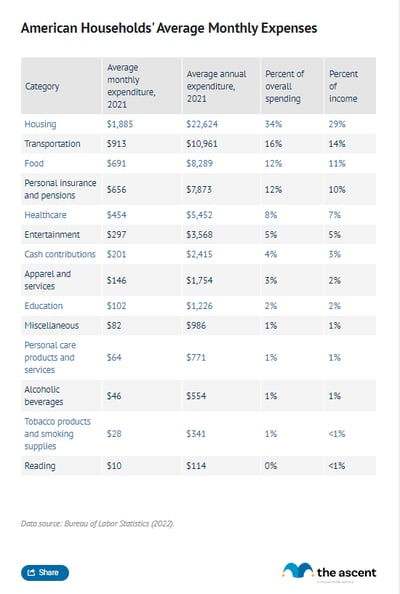
Average monthly expenses per household: $6,081
The average expenses for a single consumer unit in one month in 2022 were $6,081. Meanwhile, average spending per year came out to $72,967.
Keep in mind that the cost of living can vary by region -- some cities are cheaper to live in and others are more expensive. The figures presented in this article are national averages.
Average expenses grew 9% from 2021 to 2022, with Americans resuming the trend of spending more each year after expenditures shrunk in 2019.
You might be wondering what exactly counts as a consumer unit. BLS defines a consumer unit as any of the following:
- Families
- Single persons living alone
- Single persons sharing a household with others but who are financially independent
- Two or more people living together and sharing major expenses
For example, two parents and a child would be one consumer unit. Three roommates would be three consumer units. The average consumer unit is 2.4 people.
Average annual household income: $83,195
The average annual household income after taxes in 2022 was $83,195 and $94,003 before taxes, per the BLS.
Based on those figures, Americans spend 88% of their after-tax income and have a savings rate of 12%. That's somewhat off the recommended savings rate of 20% and a 3% decline from 2021.
While the amount you save is most important, where you put that money also matters. A good option may be a high-yield savings account to maximize the interest you earn.
Where Americans spend their money
Here's a full breakdown of the average spending by category:
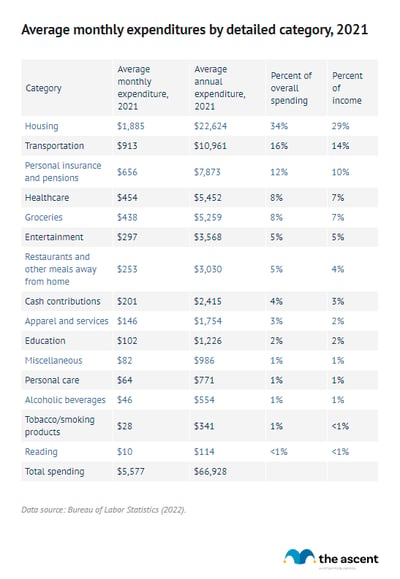
A quick note about monthly spending
The BLS survey only calculates annual spending, so we divided those numbers by 12 to get the average household expenses per month. Because we rounded to the nearest dollar, there may be small discrepancies when comparing the monthly and annual numbers.
It's also worth noting that not all of the typical expenses are monthly expenses. Some of these expenses are intermittent. For example, most people aren't spending $288 per month on entertainment. But over the course of the year, the average is $3,458.
Average monthly spending on housing: $2,025 (7% increase)
Housing is by far the largest expense for Americans. Monthly housing expenses in 2022 averaged $2,025, a 7% increase from 2021. Over the course of 2022, Americans spent $24,298 on housing on average. With housing prices cooling off somewhat in 2023, it remains to be seen how much spending will change year over year.
Of the $2,025 Americans spend on housing each month, $1,209 of it goes towards housing payments. That amount can change significantly depending on location, house size, and whether a person has roommates.
Here's a more detailed breakdown of different expenses of homeownership and how much Americans spend in each category.
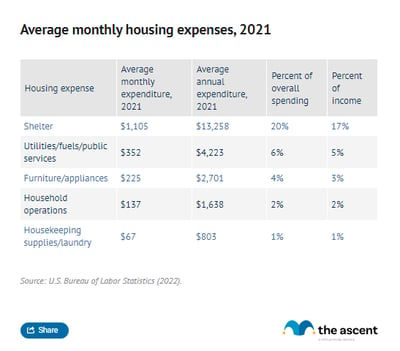
Average monthly spending on transportation: $1,025 (12% increase)
Transportation is the second-largest monthly expenditure, and Americans spent 12% more on transportation in 2022 than they did in 2021.
Transportation expenses tend to be spread out but add up to be significant. Maintenance and repairs aren't generally monthly expenses but amounted to $1,160 on average over the entire course of 2022. People don't usually buy a new car every year, but when they do, it's a major purchase. Depending on the payment schedule you choose, auto insurance could be a monthly expense or one that you pay twice a year.
Even though Americans spent more on transportation in 2022 compared to 2021, they spent 7% less on vehicle purchases ($375 a month compared to $402 a month) with most savings coming from cheaper used vehicles.
Spending on gas increased 45% year over year, a reflection of rising gas prices and Americans traveling more after the pandemic. Public transportation expenditures rocketed up 87% in 2022, continuing its return from a low in 2020.
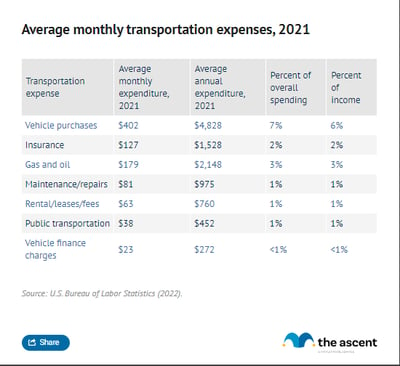
Average monthly food spending: $779 (13% increase)
Food spending includes groceries and food away from home, which is any food that you pay someone else to prepare for you. Average food spending increased 13% from 2021 to 2022. On average, Americans spent $779 per month on food in 2022 and $9,343 over the full year.
Spending on food away from home increased by 20% from 2021, continuing the post-COVID 19 trend of people spending more of their food budget at restaurants.
Grocery spending increased by 8% in 2022, mostly in line with annual increases seen since 2020.
Food prices and particularly grocery prices have been hit hard by inflation. If you've seen your own supermarket spending increase, a grocery credit card could help you save on that.
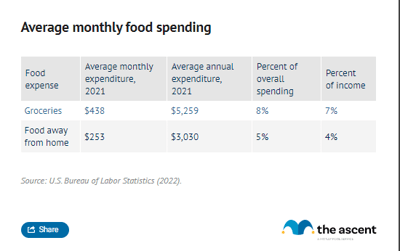
Average monthly personal insurance and pension spending: $729 (11% increase)
Personal insurance and pensions accounted for $729 in monthly spending in 2022 and $8,742 over the full year, an 11% increase from 2021.
To clarify, this category includes life insurance, personal liability insurance, accident insurance, and disability insurance. It doesn't include homeowners insurance or renters insurance, which are part of housing costs, or auto insurance, which is part of transportation.
Just 6% of spending in this category goes toward personal insurance. The remaining 94% goes to pensions and Social Security. That category includes contributions to retirement accounts and the Social Security benefits withheld from paychecks.
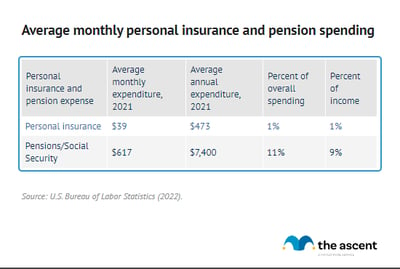
Average monthly healthcare spending: $488 (7% increase)
Average monthly healthcare spending amounted to $488 in 2022, up 7% from 2021.
Sixty-eight percent of healthcare spending in 2022 went toward health insurance premiums, which cost an average of $320. While Americans spent slightly more on health insurance premiums, the overall percentage of healthcare spending devoted to premiums declined by a small amount. Spending on drugs increased 23% year over year.
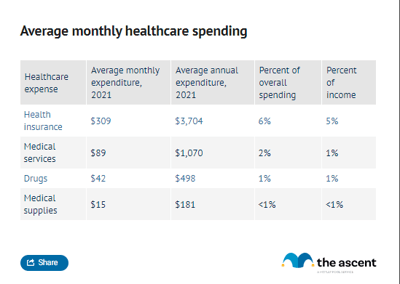
Average monthly spending on entertainment: $288 (3% decrease)
Americans spent 5% of their monthly budgets on entertainment in 2022, adding up to $288 per month and $3,458 over the course of 2022. That's down 3% from 2021, perhaps due to inflation pinching wallets and causing a pullback in discretionary spending.
BLS made some interesting decisions in what was and wasn't considered entertainment. As entertaining as pets can be, pet owners would probably argue that they deserve their own category. Avid readers may be surprised to learn that reading doesn't fall under entertainment (it has its own category instead).
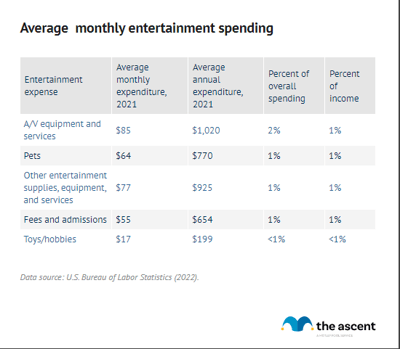
Average monthly spending on apparel and services: $162 (11% increase)
Apparel spending grew for the second year in a row after plummeting 24% from 2019 to 2020, likely due to Americans spending more time in social situations after being less concerned about dressing up during the early days of the pandemic.
Americans spent an average of $162 per month on apparel and related services in 2022, or $1,945 over the year. That's up 11% from 2021.
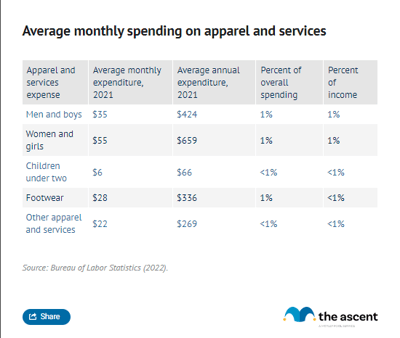
Average monthly expenses by household size
Average monthly spending can vary by household size, and data shows that although one-person households spent much less than all other households in 2022, they were the only group to spend more than their after-tax income.
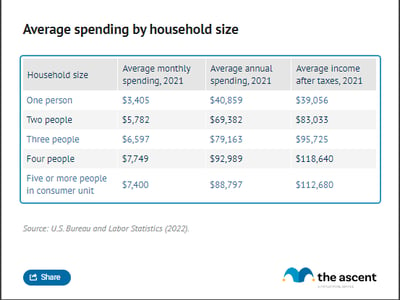
Average monthly spending by age
Americans between 45 and 54 years old spent $7,590 on average per month in 2022, the most out of any age group. Americans aged 35 to 44 years old spent a few hundred dollars less, $7,171.
Americans under 25 years old spent the least, with their average monthly expenses in 2022 coming out to $3,863. Their spending was closest to Americans at the other end of the age spectrum -- those over 65 years old spent $4,818 on average per month in 2022.
It's no surprise that Americans toward the middle of the age range are spending the most per month. That segment of the population are likely to make the most money while also having taken on significant financial responsibilities, like raising kids and paying off auto and home loans. As Americans reach retirement age, their spending quickly falls off.
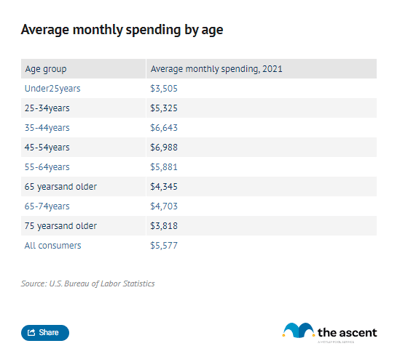
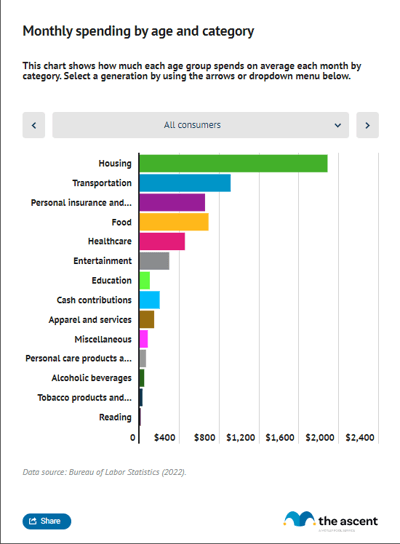
How do your average monthly expenses compare?
It's interesting to see what the typical American spending habits look like and compare them to your own. Maybe you find that you spend similar portions of your monthly income in each category, or your spending patterns could be completely different.
Neither on its own is a good or a bad thing. We all have different things we value and different areas where we're willing to spend more money. If you're happy with your spending habits and you feel financially secure, that's what's important.
If you're not able to save as much money as you like, then it's a good idea to reevaluate your typical spending and your budget. Whether it's dining out, entertainment, or something else, there could be an area where you're spending more than you realize and are able to cut back.
Sources
- U.S. Bureau of Labor Statistics (2023). "2022 Consumer Expenditure Survey."
Our Research Expert
We're firm believers in the Golden Rule, which is why editorial opinions are ours alone and have not been previously reviewed, approved, or endorsed by included advertisers. The Ascent, a Motley Fool service, does not cover all offers on the market. The Ascent has a dedicated team of editors and analysts focused on personal finance, and they follow the same set of publishing standards and editorial integrity while maintaining professional separation from the analysts and editors on other Motley Fool brands.